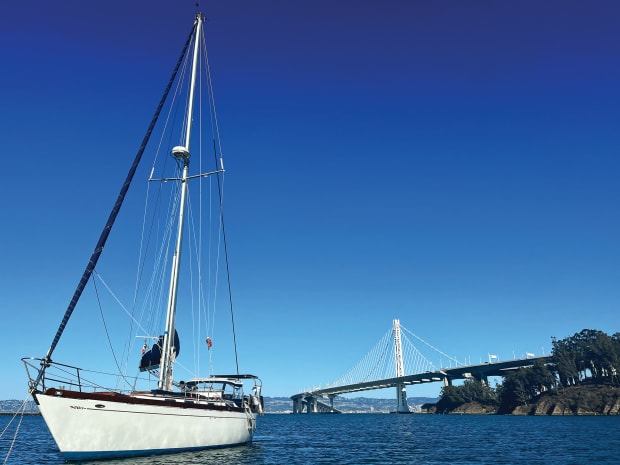
Photo by Marissa Neely
Every year, hundreds of boats in California turn left like a rite of passage, setting their course for the cruising grounds in Mexico where tacos are cheap, the sea is warm, and tequila flows like water. So why would anyone turn right and sail the “wrong way”—north against the prevailing northwest winds and seas, potentially risking it all around the infamous Point Conception? For my husband, Chris, and me, the answer was simple: Before heading down the coast, we wanted to explore our favorite places up the northern California coast in our 1979 Cheoy Lee 41, Avocet.
We’d spent the past four years in Ventura, California, refitting Avocet, preparing for the day we would sail out of the breakwater for the last time. When what looked like a perfect weather window appeared—Could it be true? A southerly predicted to blow for a week along the coast from Ventura to San Francisco?—the time had come, and we were more than ready.
We made a short hop to the familiar port of Santa Barbara, and after a night in the anchorage took off the next morning on what would be our longest passage yet together on Avocet, 301 nautical miles from Santa Barbara to San Francisco. It would be, like so many ocean passages, full of problem-solving, log-keeping, long watches, and magic.
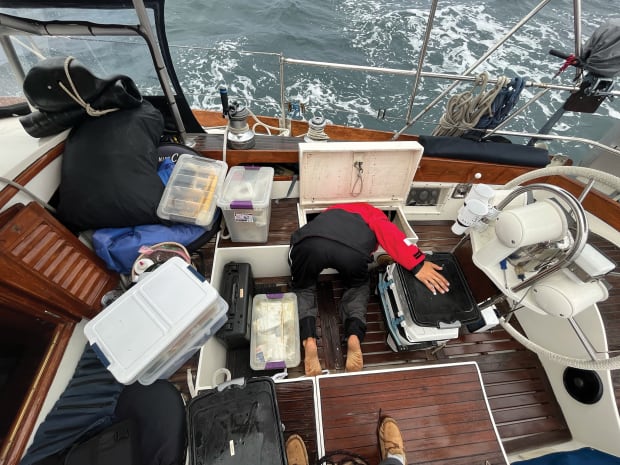
Photo by Marissa Neely
Rainbows and Repairs
I’d never seen a more spectacular sunrise than on the morning we left Santa Barbara, the sky red and painted with rainbows that cascaded from ominous clouds into the sea. The breeze had already begun to pick up while I stood at the helm watching Chris pull up the anchor. Santa Barbara shrank off our stern as Avocet sliced through the small swell, her sails full of the promised southerly winds. We had departed at 6:30 a.m., but an hour later the magic of the morning had faded into gray skies saturated with rain, soaking us in a freshwater shower. So much for treasure at the bottom of the now-vanished rainbows.
All was going smoothly, the rain sizzling as it met the sea and adding to the ever-present sounds of Avocet making way, then…“Oh, shit!” Chris gasped as he lunged towards our CPT autopilot. Metal shavings were falling from the unit that had been keeping us on course. Facing the real possibility of having to hand steer the entire way up the coast, Chris went into fix-it mode. After assessing the problem, he dove into the lazarette, removing the neatly labeled boxes until he found the one he was after. He pulled out two new shear pins, installed them, and we were back in the autopilot business.
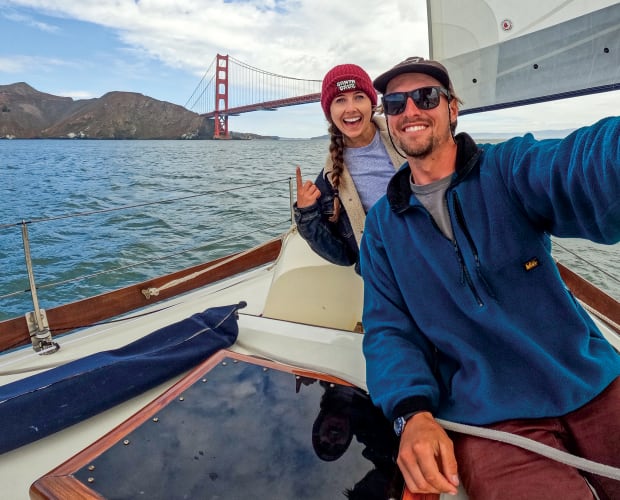
Photo by Marissa Neely
Before long, Avocet was screaming up the coast, and we watched excitedly as the knot meter kept climbing—7, 7.5, 8, 9.5! Finally, we furled some headsail to keep the boat trimmed properly. Point Conception was on our bow, close enough to plot on a chart for dead reckoning.
“Marissa, take a nap.” At the sound of Chris’ voice, I jolted up from my spot where I was slumped over the companionway like a Salvador Dalí painting. Chris was sheltered across from me under the dodger, staying out of the rain. I protested for a moment, then headed below for a nap with Cleo, the ship’s cat.
By early afternoon the rain had subsided and the wind followed suit, leaving us with the tough decision of when to resume motorsailing. If we hadn’t been trying to keep within a specific weather window, we probably would have bobbed around for a while until the wind returned, but to clear Point Conception in a timely manner with any favorable wind, we needed to maintain our speed.
The confused swell eventually found consistency at 8 feet every 6 seconds from the southwest, making things a bit more comfortable. Taking advantage of our newfound comfort, Chris was about to retire for a nap when he got a whiff of fuel, prompting him to go below and discover fuel dripping from the injector line. About half a gallon of diesel sloshed in the tray beneath our trusty—if finicky—Perkins 4.108. Weeks before our departure we had cleaned the entire diesel tank, and long before that we had replaced all the fuel lines between the tank and the engine—not to mention other upgrades.
Some salty language accompanied the oh-so-familiar sound of tools clanking in Chris’ hands as he gathered those necessary for the job. I kept my eyes on the horizon, adjusting course when crab pots and kelp interfered with our path. I could see Chris belly-down on the cabin sole with his head above the engine to determine the best fix. (Engine access isn’t great in Avocet, but at least all the floorboards are easily removable to help remedy the problem.)
Fumes filled the cockpit, and the following winds kept the nauseating smell of diesel stagnant on board.
“It isn’t fixed but it’s only a drip now,” Chris said reluctantly, wiping off his glasses, which had been soaked after a spray of diesel hit him in the face. The color was draining from his face, and I made sure he drank a full bottle of water while sitting in the fresh air.
“It’s okay,” I said, “I know you will fix it.”
To port, a massive pod of dolphins swam north with us, and just behind them two whales breached. The clouds parted like a curtain revealing the warmth of the sun that thawed our foulie-covered bodies. Shortly after we scarfed down pizza for dinner, we did a final systems check and Chris retired below. It was officially my first solo watch of the passage, and I’d be at the helm from 8 to 11 p.m, later if I could manage to stay awake.
Clearing the Cape
Steam from a cup of tea warmed my chin as I held it close to my chest for warmth. The nighttime chill had set in, and despite my attempts at huddling beneath my favorite blanket, I was still fighting to keep my body temperature up. “We’re not in Southern California anymore,” I said between shivers to Cleo, my favorite watch buddy.
The moon took her place in a sky of diamonds, the Milky Way on full display off our stern quarter with the Big Dipper off our bow. An hour later, the night sky vanished into the fog. Two dolphins startled me when they cut through the water leaving phosphorescent trails that resembled a pair of torpedoes heading straight for our boat.
I scanned the horizon for crab pots and other hazards with no real help from our spotlight since it reflected off the soupy fog and back into my face. Not being able to see more than 15 feet ahead of the bow was frightening; the unknown of what lay ahead let my mind creatively fill in the void, resulting in real-time nightmares. Is that a ship? I wondered as the ever-growing glow of something in the distance hovered on the horizon. I was tired, excited, on edge, and nervous all at the same time.
But as the hours passed, a natural rhythm took over. The uncertainty subsided and my eyes adjusted to the night sky, such as it was. As Avocet confidently cut through the sea, I was reminded that she is much more durable than we are. From the years of refits and sticky situations, we knew her inside and out. She had never failed us, and we trusted her. With that realization, I felt completely at ease bundled up in the cockpit with our course set for the darkness ahead of us. And right when I thought the visibility couldn’t get worse, it did, and my watch was over.
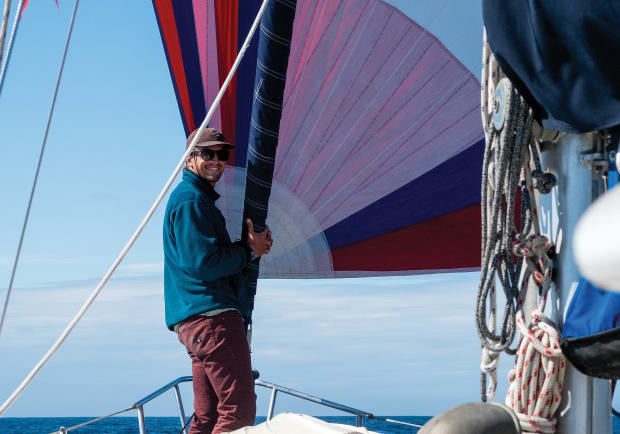
Photo by Marissa Neely
Chris’ Log: 2400 Fog lifted above the skyline to be able to see shore, passing Pismo now. Will be near Morro Bay in about 4 hrs. Seas have flattened dramatically, swell is maybe 1 foot every 10 seconds. Wind is light but present from the east, about 5 kts. Engine running well, with the weather window closing I think we will push past Morro and head straight to SF. 0200: No sighting of boat, or animals. Fog has lifted, uneventful watch. It’s cold.
At 2:30 in the morning Chris woke me, and I readied myself for watch when we would round Point Conception.
Commonly regarded as the Cape Horn of the west, Point Conception is notorious for sneaker waves that rise from the deep like snatching hands to grab the unsuspecting sailor. And there’s the cape effect that brings winds seemingly from nowhere and everywhere all at once, strong enough to tear sails and humble seasoned seafarers.
Naturally, the fog that had dissipated during Chris’ watch returned as soon as I emerged, much thicker than when I went to sleep. Our AIS receiver on our radio wasn’t working, so before Chris left me on my own, he showed me how to access AIS through his phone via marinetraffic.com. The forecast had correctly predicted 13-knot winds from the southwest, an 8- to 10-foot swell from the northwest, and 4-foot chop making the sea state a bit confused. It was lumpy, but nothing Avocet couldn’t handle. We rounded the point in under two hours, wearing the success on our sleeve like a badge of honor.
My exciting watch was coming to an end, but I decided to stick it out for as long as I could to let Chris rest and to see the sunrise. We had officially been underway for 24 hours—the longest passage we had done to date as Avocet’s crew. Eventually Chris relieved me of my watch when he woke himself up and insisted that I get some rest. I was still wired from rounding the infamous point, but reluctantly I agreed to try and get some sleep, if anything to get warm. My hands were full of pins and needles as I tucked them beneath the blankets in our bed that was still warm from Chris’ lingering body heat.
Chris’ Log: 0630-0930: Great sunrise. Nothing Happened.
By 11 a.m. the next morning, the breeze was still too light for sailing only, so we reluctantly compromised and motorsailed. The brunt of the rain seemed to be behind us, and in an hour or so the breeze began to pick up enough to fill the sails—well, a sail. Chris and I quickly raised our spinnaker that filled with a satisfying “whomp.” What a treat to be sailing up the California coast the wrong way under the chute! We were celebrating this thrill when suddenly Chris said, “I know how to fix it!”
He darted below. I kept my questions to myself as he tinkered with the engine again. About half an hour passed before he yelled, “I did it!” Unlike his last fix-it attempt, he wasn’t dripping with diesel and showed no signs of nausea. The leak was gone; sadly, so was the wind.
The sun was warm as it fell onto us in the early hours of the afternoon, inspiring Chris to shower in the cockpit while I made dinner. He was a new man after a win with the engine and freshwater rinse.
“Do you want to take first watch?” Chris asked. Honestly, I was getting tired, but the wind was just starting to fill in, and I wanted to wait until the engine was off to sleep. Maybe I should have listened, though, because when Chris went forward to lower the mainsail to keep it from blanketing our headsail, he underestimated his strength and ripped a 4-foot hole directly through the leech—which was already needing mending since we had snapped the leech line a couple days before.
More salty language ensued. With the sail lowered safely into the stack pack, he assessed the damage. He could patch it with sail tape for the time being. One thing was for certain: A new sail and some repairs were in our future.
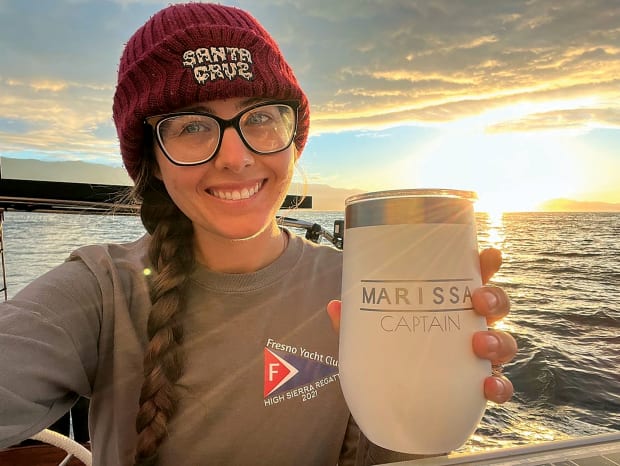
Marissa greets the day with a warm beverage.
Photo by Marissa Neely
Through the Golden Gate
My watch began at midnight with Chris noting a cruise ship in the distance. I hoped the city-like glow on the ocean would remain just that—a distant glow. Being a walking testament for Murphy’s Law, I instantly felt rain starting again as soon as I took my place in the cockpit. My ability to see was contained to a single beam of light aimlessly pointed at the sea as I attempted to keep a lookout for crab pots camouflaged in the darkness.
Eventually, a sliver of moon peeked its shy head over the pitch-black horizon, casting a faint light. The ocean was eerily still, and the soft southerly breeze seduced me into a false sense of security. Just as the fog began to lift a bit, the sky went white with lightning. It was 3:00 a.m., and I was doing my best to count the seconds after the strike, waiting to hear the thunder that never came.
“It must be far away,” I said to Cleo, petting her head as her yellow eyes stared back at me. It was the first strike of many as time pressed on, keeping me on my toes for the rest of my watch.
Chris’ Log: Cold. Wet. Boring.
At 9 the next morning, something new and strange: sunshine forcing my eyes to open. I popped my head out of the companionway to see Chris in a damp but sunny cockpit smiling ear to ear.
“You can see the gate!” he said.
Sun? In San Francisco? We weren’t complaining one bit but were pleasantly surprised by the lack of fog that is such a part of the Bay area culture that the locals have given it a name, Karl. We were still motoring due to the lack of wind, but as we neared the bridge I could see sailboats tacking back and forth in the Bay.
“This is really happening,” I said. Sailing under the Golden Gate wing-on-wing was like sprinting through the finish line of a marathon, and we made our way beneath it as the city’s urban symphony filled our ears. By 5 p.m., the hook was down. The long, slow hum of the Bay’s foghorn closed the logbook on a passage that may have been the wrong way but had turned out to be more than all right.
Marissa Neely lives aboard her Cheoy Lee 41 with her partner, Chris, and cat, Cleo. Catch their adventures at svavocet.com.
March 2023








